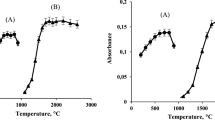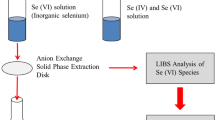Abstract
In this work, we present a new method for the determination and speciation of selenium in water with ion chromatography (IC) using a conductometric detector. Chromatographic parameters such as mobile phase concentration, and columns type were optimized. The established method is checked for interference with possible anions. AS 11 showed better speciation as well as separation of peaks for selenium in presence of other common ions. The method detection limit was found to be 0.046 μg L−1 and 0.015 μg L−1 for Se (IV) and Se (VI), respectively, with AS11 column coupled with conductivity detector. The reported method is demonstrated for selenium detection in 10–5000 μg L−1 range. The developed method is a substitute to expensive ICP-MS for selenium analysis and speciation within WHO permissible limit. It is also applied to determine the selenium in real water samples. The current work paves a simpler approach for selenium detection and speciation for their field mapping.





Similar content being viewed by others
References
Zhang N et al (2011) Simultaneous multi-channel hydride generation atomic fluorescence spectrometry determination of arsenic, bismuth, tellurium and selenium in tea leaves. Food Chem 124(3):1185–1188
Tamari Y (1998) Methods of analysis for the determination of selenium in biological, geological, and water samples. Environmental chemistry of selenium. Marcel Dekker Inc, New York, pp 27–46
Edition F (2011) Guidelines for drinking-water quality. WHO Chron 38(4):104–108
Epa U (2009) National primary drinking water regulations. In: Arsenic and clarifications to
Chandrasekaran K, Ranjit M, Arunachalam J (2009) Determination of inorganic selenium species [Se (IV) and Se (VI)] in tube well water samples in Punjab India. Chem Speciat Bioavailab 21(1):15–22
Takahashi K, Suzuki N, Ogra Y (2017) Bioavailability comparison of nine bioselenocompounds in vitro and in vivo. Int J Mol Sci 18(3):506
Fernández-Martínez A, Charlet L (2009) Selenium environmental cycling and bioavailability: a structural chemist point of view. Rev Environ Sci Bio/Technol 8(1):81–110
Wojcik P, Pyrzyńska K, Biesaga M (2003) Ion-chromatography of inorganic selenium species with a preliminary preconcentration step. Chromatographia 57(1):S67–S71
Olivas RM et al (1994) Analytical techniques applied to the speciation of selenium in environmental matrices. Anal Chim Acta 286(3):357–370
Dauchy X et al (1994) Analytical methods for the speciation of selenium compounds: a review. Fresenius J Anal Chem 348(12):792–805
Pyrzynska K (1998) Speciation of selenium compounds. Anal Sci 14(3):479–483
Lam JW, Sturgeon RE, McLaren JW (1999) Ultra-trace determination of Se in sediments by electrothermal vaporizer-inductively coupled plasma-mass spectroscopy: use of the ETV as a thermochemical reactor. Spectrochim Acta, Part B 54(3–4):443–453
Boulyga SF, Becker JS (2001) ICP–MS with hexapole collision cell for isotope ratio measurements of Ca, Fe, and Se. Fresenius J Anal Chem 370(5):618–623
Murayama M, Suzuki M, Takitani S (1988) Determination of selenium in bulk prednisolone by ion chromatography. Anal Sci 4(4):389–392
Miekeley N et al (2005) Inorganic speciation analysis of selenium by ion chromatography-inductively coupled plasma-mass spectrometry and its application to effluents from a petroleum refinery. Spectrochim Acta, Part B 60(5):633–641
Zheng J et al (2000) Speciation of selenium compounds with ion-pair reversed-phase liquid chromatography using inductively coupled plasma mass spectrometry as element-specific detection. J Chromatogr A 874(1):55–64
Lindemann T, Hintelmann H (2002) Selenium speciation by HPLC with tandem mass spectrometric detection. Anal Bioanal Chem 372(3):486–490
Kashiwagi Y, Kokufuda E, Yamashita Y (2001) Lanthanum hydroxide co-precipitation separation/reduction distillation/graphite-moderated light salt concentration by atomic absorption method Separate quantification of inorganic arsenic (III, V) and organic arsenic in wastewater. Anal Chem Japan Anal 50(3):187–192
Kölbl G, Kalcher K, Irgolic KJ (1993) Ion chromatographic determination of selenite and selenate with selenium-specific detection by flame and graphite furnace atomic absorption spectrometry. Anal Chim Acta 284(2):301–310
Jen J-F, Yang Y-J, Cheng C-H (1997) Simultaneous speciation of aqueous selenium (IV) and selenium (VI) by high-performance liquid chromatography with ultraviolet detection. J Chromatogr A 791(1–2):357–360
Harwood JJ, Wen S (1997) Analysis of organic and inorganic selenium anions by ion chromatography-inductively coupled plasma atomic emission spectroscopy. J Chromatogr A 788(1–2):105–111
Gómez-Ariza J et al (2000) Column-switching system for selenium speciation by coupling reversed-phase and ion-exchange high-performance liquid chromatography with microwave-assisted digestion–hydride generation–atomic fluorescence spectrometry. J Chromatogr A 889(1–2):33–39
McSheehy S et al (2000) Speciation analysis of selenium in garlic by two-dimensional high-performance liquid chromatography with parallel inductively coupled plasma mass spectrometric and electrospray tandem mass spectrometric detection. Anal Chim Acta 421(2):147–153
Wallschläger D, Bloom NS (2001) Determination of selenite, selenate and selenocyanate in waters by ion chromatography-hydride generation-atomic fluorescence spectrometry (IC-HG-AFS). J Anal At Spectrom 16(11):1322–1328
Do B et al (2001) Speciation of arsenic and selenium compounds by ion-pair reversed-phase chromatography with electrothermic atomic absorption spectrometry: application of experimental design for chromatographic optimisation. J Chromatogr A 918(1):87–98
Cai Y et al (1995) On-line preconcentration of selenium (IV) and selenium (VI) in aqueous matrices followed by liquid chromatography-inductively coupled plasma mass spectrometry determination. Anal Chim Acta 314(3):183–192
Bueno MT, Potin-Gautier M (2002) Solid-phase extraction for the simultaneous preconcentration of organic (selenocystine) and inorganic [Se (IV), Se (VI)] selenium in natural waters. J Chromatogr A 963(1–2):185–193
Geng X et al (2008) Determination of organic acids in the presence of inorganic anions by ion chromatography with suppressed conductivity detection. J Chromatogr A 1192(1):187–190
Wagner HP et al (2007) Selective method for the analysis of perchlorate in drinking waters at nanogram per liter levels, using two-dimensional ion chromatography with suppressed conductivity detection. J Chromatogr A 1155(1):15–21
Xu S et al (2012) Nano TiO2-based preconcentration for the speciation analysis of inorganic selenium by using ion chromatography with conductivity detection. Microchem J 101:70–74
Miller JC, Miller JN (1988) Basic statistical methods for analytical chemistry. Part I. Statistics of repeated measurements: a review. Analyst 113(9):1351–1356
Acknowledgements
The sincere support and encouragement from Director, CSIR-Central Scientific Instruments Organisation, Chandigarh, is highly acknowledged. Financial support under CSIR-FBR project, MLP0058, is acknowledged. A. Malakar thanks NET for salary support.
Author information
Authors and Affiliations
Corresponding author
Ethics declarations
Conflict of Interest
The authors declare that they have no conflict of financial interests or personal relationships that could have appeared to influence the work reported in this paper.
Additional information
Publisher's Note
Springer Nature remains neutral with regard to jurisdictional claims in published maps and institutional affiliations.
Supplementary Information
Below is the link to the electronic supplementary material.
Rights and permissions
About this article
Cite this article
Borah, P., Chetan, Sharma, V. et al. A Facile Method for Detection and Speciation of Inorganic Selenium with Ion Chromatography. Chromatographia 85, 213–218 (2022). https://doi.org/10.1007/s10337-021-04120-0
Received:
Revised:
Accepted:
Published:
Issue Date:
DOI: https://doi.org/10.1007/s10337-021-04120-0




